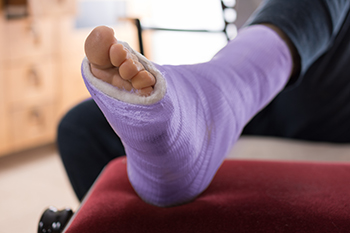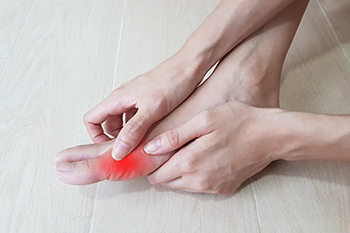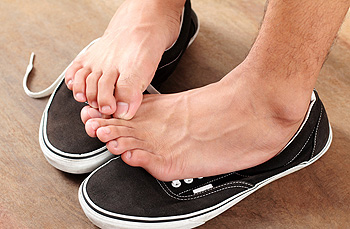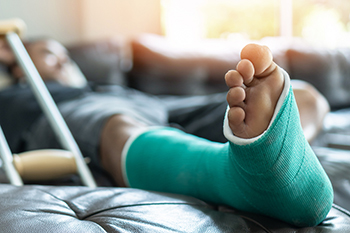

A broken ankle, a distressing and often unexpected injury, can significantly disrupt daily life. Numerous factors can lead to this type of fracture, reminding us of the intricate vulnerability of our feet. Accidents and falls are among the primary culprits, especially when landing awkwardly or with force. High impact sports and activities, marked by sudden twists or impacts, also pose a risk. Osteoporosis is a medical condition that can weaken bones, making them more susceptible to fractures from even minor impacts. Recognizing these triggers is crucial for preventing broken ankles. Employing protective gear, wearing proper footwear, and implementing cautious movement can collectively contribute to foot safety. A broken ankle is painful and generally happens immediately. If you have endured this type of injury, it is suggested that you confer with a podiatrist who can effectively diagnose and treat a broken ankle.
Broken ankles need immediate treatment. If you are seeking treatment, contact the podiatrists from The Foot & Ankle Center of New Jersey. Our doctors can provide the care you need to keep you pain-free and on your feet.
Broken Ankles
A broken ankle is experienced when a person fractures their tibia or fibula in the lower leg and ankle area. Both of these bones are attached at the bottom of the leg and combine to form what we know to be our ankle.
When a physician is referring to a break of the ankle, he or she is usually referring to a break in the area where the tibia and fibula are joined to create our ankle joint. Ankles are more prone to fractures because the ankle is an area that suffers a lot of pressure and stress. There are some obvious signs when a person experiences a fractured ankle, and the following symptoms may be present.
Symptoms of a Fractured Ankle
If you suspect an ankle fracture, it is recommended to seek treatment as soon as possible. The sooner you have your podiatrist diagnose the fracture, the quicker you’ll be on the way towards recovery.
If you have any questions, please feel free to contact our office located in Paramus, NJ . We offer the newest diagnostic and treatment technologies for all your foot care needs.

Maintaining good circulation is vital for overall health. Symptoms often noticed in the feet include a numbing or tingling sensation and they may feel cold. There are methods that can be implemented that may help to prevent poor circulation naturally. First, stay active and engage in regular exercise to promote blood flow. Avoid sitting or standing for prolonged periods of time, and take short walks or stretch breaks. Maintain a healthy diet, including foods rich in antioxidants and essential nutrients. Quit smoking, as it constricts blood vessels and hinders circulation. Manage stress through relaxation techniques, like meditation or yoga. Opt for compression socks or stockings to improve blood flow in the legs. Keep your body hydrated and avoid excessive alcohol consumption. Ensure proper posture and avoid crossing your legs when sitting. Finally, avoid tight-fitting clothing that can restrict blood flow. If you notice signs of poor circulation in your feet, it is suggested that you consult with a podiatrist who can help you to manage this condition.
While poor circulation itself isn’t a condition; it is a symptom of another underlying health condition you may have. If you have any concerns with poor circulation in your feet contact the podiatrists of The Foot & Ankle Center of New Jersey. Our doctors will treat your foot and ankle needs.
Poor Circulation in the Feet
Peripheral artery disease (PAD) can potentially lead to poor circulation in the lower extremities. PAD is a condition that causes the blood vessels and arteries to narrow. In a linked condition called atherosclerosis, the arteries stiffen up due to a buildup of plaque in the arteries and blood vessels. These two conditions can cause a decrease in the amount of blood that flows to your extremities, therefore resulting in pain.
Symptoms
Some of the most common symptoms of poor circulation are:
Treatment for poor circulation often depends on the underlying condition that causes it. Methods for treatment may include insulin for diabetes, special exercise programs, surgery for varicose veins, or compression socks for swollen legs.
As always, see a podiatrist as he or she will assist in finding a regimen that suits you. A podiatrist can also prescribe you any needed medication.
If you have any questions, please feel free to contact our office located in Paramus, NJ . We offer the newest diagnostic and treatment technologies for all your foot care needs.

Gout is a painful arthritis caused by uric acid buildup in the body, leading to joint redness, tenderness, and severe pain. It commonly affects the feet and specifically the big toe, but can impact other joints, like the ankles, elbows, wrists, fingers, and knees. Symptoms include intense joint pain, joint inflammation, and limited range of movement. Gout is typically more common in individuals with high levels of uric acid in their bodies. Several factors contribute to this condition, including obesity, family history of gout, being male, consuming foods higher in purines, and specific medical conditions like untreated high blood pressure, diabetes, and heart and kidney diseases. Diagnosing gout involves a physical examination and may include tests such as uric acid blood tests and joint aspiration to check for urate crystals. Adopting a healthy diet, maintaining a proper body weight to prevent obesity, and making lifestyle changes like reducing alcohol and sweetened beverage consumption can be beneficial in managing gout effectively. If you suspect you have gout, it is strongly suggested that you make an appointment with a podiatrist for a proper diagnosis and treatment.
Gout is a painful condition that can be treated. If you are seeking treatment, contact the podiatrists from The Foot & Ankle Center of New Jersey. Our doctors will treat your foot and ankle needs.
What Is Gout?
Gout is a form of arthritis that is characterized by sudden, severe attacks of pain, redness, and tenderness in the joints. The condition usually affects the joint at the base of the big toe. A gout attack can occur at any random time, such as the middle of the night while you are asleep.
Symptoms
Risk Factors
Prior to visiting your podiatrist to receive treatment for gout, there are a few things you should do beforehand. If you have gout you should write down your symptoms--including when they started and how often you experience them, important medical information you may have, and any questions you may have. Writing down these three things will help your podiatrist in assessing your specific situation so that he or she may provide the best route of treatment for you.
If you have any questions, please feel free to contact our office located in Paramus, NJ . We offer the newest diagnostic and treatment technologies for all your foot care needs.

The strong band of tissue that runs from the calf muscles to the heel bone is known as the Achilles tendon. When this tendon is overused, which is frequent among runners, dancers, and other athletes, it can become inflamed and extremely painful. This condition is called Achilles tendinopathy. The top cause of Achilles tendinopathy is overuse, which tears or stretches the tendon and causes inflammation. Other causes include certain types of arthritis, flat feet, and overpronation. In addition, wearing shoes that lack adequate support, being overweight, and taking certain antibiotics may increase the likelihood of developing Achilles tendinopathy. There are a number of treatments available for Achilles tendinopathy, but healing time depends on the severity of the injury. In some cases, surgery is required. There are several ways to prevent tendinopathy, including stretching exercises and warmup and cool-down routines. Wearing proper footwear is another way to help prevent this injury. For more information, it is suggested that you consult a podiatrist.
Achilles tendon injuries need immediate attention to avoid future complications. If you have any concerns, contact the podiatrists of The Foot & Ankle Center of New Jersey. Our doctors can provide the care you need to keep you pain-free and on your feet.
What Is the Achilles Tendon?
The Achilles tendon is a tendon that connects the lower leg muscles and calf to the heel of the foot. It is the strongest tendon in the human body and is essential for making movement possible. Because this tendon is such an integral part of the body, any injuries to it can create immense difficulties and should immediately be presented to a doctor.
What Are the Symptoms of an Achilles Tendon Injury?
There are various types of injuries that can affect the Achilles tendon. The two most common injuries are Achilles tendinitis and ruptures of the tendon.
Achilles Tendinitis Symptoms
Rupture Symptoms
Treatment and Prevention
Achilles tendon injuries are diagnosed by a thorough physical evaluation, which can include an MRI. Treatment involves rest, physical therapy, and in some cases, surgery. However, various preventative measures can be taken to avoid these injuries, such as:
If you have any questions please feel free to contact our office located in Paramus, NJ . We offer the newest diagnostic tools and technology to treat your foot and ankle needs.

Research indicates that approximately one-third of the American population is obese. The feet can be impacted when extra weight is placed on them, and various foot conditions can develop. Obesity can cause the misalignment of various areas in the body, and the feet can feel the brunt of this. It is said that one pound of weight can increase the pressure on the feet and ankles by as much as eight pounds. This can become uncomfortable as the weight increases and may worsen while walking up the steps. A common foot condition that can occur from being obese is overpronation. This is described as the foot rolling inward while walking, which can result from flattened arches. Stress on the joints in the feet may evolve into osteoarthritis caused by excessive wear and tear. The chances of losing weight are increased when a gentle exercise routine is frequently followed. If you have questions about any foot pain you may be experiencing with weight gain, it is suggested that you confer with a podiatrist who can guide you toward a healthier lifestyle.
Obesity has become very problematic at this point in time and can have extremely negative effects on the feet. If you’re an obese individual and are concerned about your feet, contact the podiatrists from The Foot & Ankle Center of New Jersey. Our doctors can provide the care you need to keep you pain-free and on your feet.
Obesity and Your Feet
Since your feet are what support your entire weight when standing, any additional weight can result in pain and swelling. Being overweight is one of the main contributors to foot complications.
Problems & Complications
Extra Weight – Even putting on just a few extra pounds could create serious complications for your feet. As your weight increases, your balance and body will shift, creating new stresses on your feet. This uneven weight distribution can cause pain, even while doing the simplest tasks, such as walking.
Diabetes – People who are overweight are at serious risk of developing type-2 diabetes, which has a drastic impact on the health of your feet. As you get older, your diabetes might worsen, which could lead to loss of feeling in your feet, sores, and bruises. You could also become more prone to various infections.
Plantar fasciitis – Pressure and stress that is placed on muscles, joints, and tendons can trigger plantar fasciitis, which is an inflammation of tissue that forms along the bottom of the foot.
If you have any questions please feel free to contact our office located in Paramus, NJ . We offer the newest diagnostic and treatment technologies for all your foot and ankle needs.

When a distinct foul odor emanates from your shoes or feet, it can be an indication of an infection. Bacteria thrive in warm, moist atmospheres, such as the inside of a shoe or between the toes. Two types of bacteria are common causes of foot odor as they interact with the sweat on the feet and produce chemicals that smell bad. Isovaleric acid emanates a cheesy, sweaty foot odor, while propionic acid projects a sour smell. In addition, brevibacteria, which eats the dead skin on the toes, can produce a gas that also smells sour. Socks and shoes that don’t allow sweat to evaporate from the skin can be another cause of foot odor. A fungal infection, or tinea, frequently termed athlete’s foot, can also result in foot odor. The first line of defense against smelly feet is developing a daily foot care and hygiene regime. Wash and dry the feet thoroughly, especially between the toes. Allow your shoes and socks to dry completely between wearings. If foot odor is an ongoing problem for you, it is suggested that you make an appointment with a podiatrist for an evaluation and possible treatment options.
Everyday foot care is very important to prevent infection and other foot ailments. If you need your feet checked, contact the podiatrists from The Foot & Ankle Center of New Jersey. Our doctors can provide the care you need to keep you pain-free and on your feet.
Everyday Foot Care
Often, people take care of their bodies, face and hair more so than they do for their feet. But the feet are a very important aspect of our bodies, and one that we should pay more attention to. Without our feet, we would not be able to perform most daily tasks.
It is best to check your feet regularly to make sure there are no new bruises or cuts that you may not have noticed before. For dry feet, moisturizer can easily be a remedy and can be applied as often as necessary to the affected areas. Wearing shoes that fit well can also help you maintain good foot health, as well as making it easier to walk and do daily activities without the stress or pain of ill-fitting shoes, high heels, or even flip flops. Wearing clean socks with closed shoes is important to ensure that sweat and bacteria do not accumulate within the shoe. Clean socks help to prevent Athlete’s foot, fungi problems, bad odors, and can absorb sweat.
If you have any questions please feel free to contact our office located in Paramus, NJ . We offer the newest diagnostic and treatment technologies for all your foot and ankle needs.

The ankles play a significant role in balancing the weight of the body and are strong enough to endure participating in strenuous activities. They are also flexible and may be susceptible to breaking, which can happen from landing awkwardly on a hard surface. One of the first signs you may have that you have broken your ankle is severe pain. This is considered to be the body’s natural defense against an injury, and the pain level happens accordingly to the severity of the injury. Other symptoms may include a numbing sensation and immediate swelling, and it is often difficult, if not impossible to walk. A severely broken ankle may have a bone protruding from the skin, which may bleed and become infected. A diagnosis is often performed that can confirm the broken ankle, and treatment can begin. Many people wear a cast or protective boot as their fractured ankle heals, and this may provide an opportunity for mobility. If you have broken your ankle, it is suggested that you confer with a podiatrist who can determine what the best form of treatment is for you.
Broken ankles need immediate treatment. If you are seeking treatment, contact the podiatrists from The Foot & Ankle Center of New Jersey. Our doctors can provide the care you need to keep you pain-free and on your feet.
Broken Ankles
A broken ankle is experienced when a person fractures their tibia or fibula in the lower leg and ankle area. Both of these bones are attached at the bottom of the leg and combine to form what we know to be our ankle.
When a physician is referring to a break of the ankle, he or she is usually referring to a break in the area where the tibia and fibula are joined to create our ankle joint. Ankles are more prone to fractures because the ankle is an area that suffers a lot of pressure and stress. There are some obvious signs when a person experiences a fractured ankle, and the following symptoms may be present.
Symptoms of a Fractured Ankle
If you suspect an ankle fracture, it is recommended to seek treatment as soon as possible. The sooner you have your podiatrist diagnose the fracture, the quicker you’ll be on the way towards recovery.
If you have any questions, please feel free to contact our office located in Paramus, NJ . We offer the newest diagnostic and treatment technologies for all your foot care needs.

Plantar fasciitis is a foot condition that can cause severe pain and discomfort, and walking can be difficult. The plantar fascia is found on the sole of the foot, and it connects the heel to the toes. It can gradually become irritated or torn from standing on hard surfaces for most of the day, propelling many patients to look for relief. It may also come from wearing shoes that do not fit correctly. Additionally, an injury to the plantar fascia may cause it to become damaged, which can lead to sudden pain. Some people find it can help to perform specific stretches that can provide comfort. Grasping and releasing a towel with the toes can be effective in stretching the plantar fascia, in addition to standing on a book and curling the toes around the edge. This is followed by straightening them out, and can be repeated several times. Ankle circles are an easy exercise to perform. This can be accomplished by rotating the ankle in a clockwise direction, then switching to counter clockwise. Repeating this numerous times on each foot may help to reduce the pain of plantar fasciitis. If you have heel pain, it is strongly suggested that you confer with a podiatrist who can accurately diagnose plantar fasciitis, and guide you toward correct treatment solutions.
Plantar fasciitis is a common foot condition that is often caused by a strain injury. If you are experiencing heel pain or symptoms of plantar fasciitis, contact the podiatrists from The Foot & Ankle Center of New Jersey. Our doctors can provide the care you need to keep you pain-free and on your feet.
What Is Plantar Fasciitis?
Plantar fasciitis is one of the most common causes of heel pain. The plantar fascia is a ligament that connects your heel to the front of your foot. When this ligament becomes inflamed, plantar fasciitis is the result. If you have plantar fasciitis you will have a stabbing pain that usually occurs with your first steps in the morning. As the day progresses and you walk around more, this pain will start to disappear, but it will return after long periods of standing or sitting.
What Causes Plantar Fasciitis?
There are some risk factors that may make you more likely to develop plantar fasciitis compared to others. The condition most commonly affects adults between the ages of 40 and 60. It also tends to affect people who are obese because the extra pounds result in extra stress being placed on the plantar fascia.
Prevention
There are a variety of treatment options available for plantar fasciitis along with the pain that accompanies it. Additionally, physical therapy is a very important component in the treatment process. It is important that you meet with your podiatrist to determine which treatment option is best for you.
If you have any questions, please feel free to contact our office located in Paramus, NJ . We offer the newest diagnostic and treatment technologies for all your foot care needs.